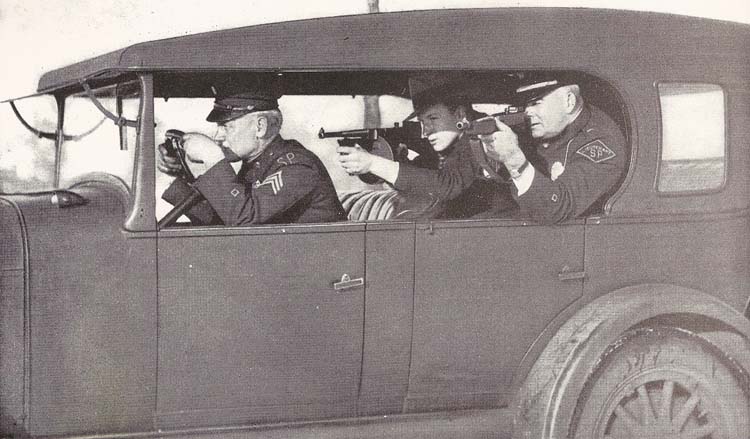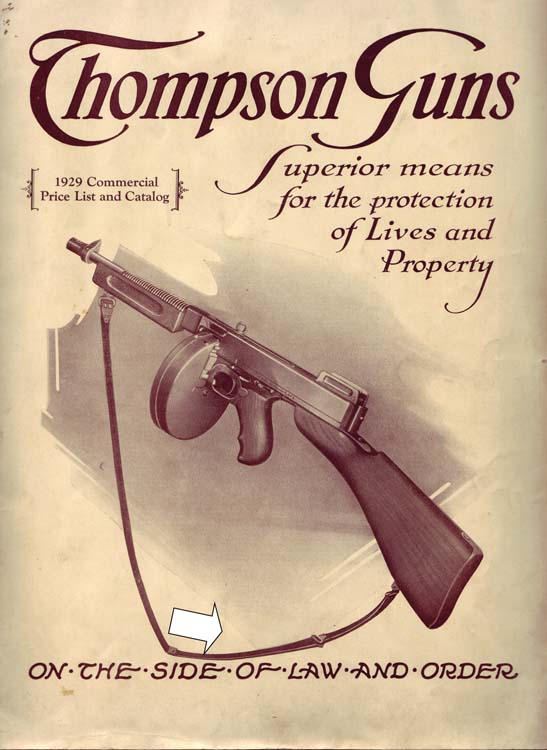
The slogan displayed on the front of the 1929 Commercial Price List and Catalog, Superior means for the protection of Lives and Property, is indicative of another marketing attempt by Auto-Ordnance Corporation (AOC) to sell the Thompson gun. One of their first catchphrases, The Most Effective Portable Fire Arm In Existence, had run its course. The old stand-by maxim, On The Side Of Law And Order, was still in use but AOC must have felt the need for something new in 1929 – eight years after the introduction of the Thompson submachine gun.
The 1929 catalog, as it has come to be known by collectors, was double the size of previous catalogs. It was filled with a lot of pictures and interesting information on the Thompson gun – all in all a very nice product. Most 1929 catalogs measure 12” x 9” but there is some slight variation in size with different printings, i.e., the E.E. Richardson (a well known AOC salesman) marked 1929 catalog.

This is a very desirable item for Thompson paper collectors, one that is hard to find and usually expensive when found. It is not uncommon for original 1929 catalogs in excellent condition to sell for over $500. The survival rate for the 1929 catalog does not appear to be anywhere near that of the 1936 Nassau Street catalog.
As with most things Thompson if there are not enough originals to satisfy demand, reproduction items will soon enter the market place. This is exactly what happened with the 1929 catalog. Reproductions sold years ago from Ray Riling Arms and Frontier Press are well known by Thompson enthusiasts. While both of these catalogs are professionally marked as reproductions by the printer, it is very easy for a paper collector to determine by the quality of print and pictures that these two reproduction catalogs are not original. However, these reproductions do fill a void in most collections and allow for reading without the possibility of damaging an original.
Such was the universe for the 1929 catalog – until recently. Last year, what appeared to be original 1929 AOC catalogs unexpectedly hit the market. The picture quality was excellent and it was obvious the catalog had some age. Touted as original catalogs by sellers, many of whom had probably never seen an original 1929 catalog, the price began to rise.
This author made a purchase and was very pleased when the package first arrived. However, upon careful inspection there was something about this catalog that seemed amiss. There were definite signs of aging around the corners and the staples had started to rust – but the color was just not right. The cover on an original 1929 catalog is more of a brownish color; the cover on these “new” 1929 catalogs is more of an off-white color. Fortunately, Small Arms Review writer David Albert lives only a short distance away. David is the co-author of the book, Thompson Manuals, Catalogs and Other Paper Items. He has a very extensive Thompson paper collection, including an original 1929 catalog.

A side by side comparison soon illustrated that this “new” 1929 catalog was not quite the quality of an original. To be certain, it was a piece of excellent work though the color difference of the cover was quite pronounced when the documents were laid side by side. In addition, the background color or shading (on the cover) is much more pronounced on the original catalog. Unfortunately, many Thompson paper collectors do not have ready access to a known original. And pictures from the best reference books allow only a preliminary comparison of the cover.
An investigation into where these “new” 1929 catalogs originated from proved interesting but was not definitive. Several sellers were contacted and a central theme in all stories soon developed: Atlanta, Georgia. Every story included reference to an estate sale and how the catalogs were stored in a “wooden crate” or “wooden box” and never released for sale. There were similarities to all the stories and the sellers were definitely not experts in the Thompson world. They were in the business of buying and re-selling items for a profit. All spoke freely and did not appear to be withholding information. The estate sale in one story involved a decedent in Florida who previously lived in upstate New York. Aside from the catalogs and a lot of sawdust, the wooden box purportedly contained several Thompson bolts, barrels and two receivers. The receivers were dispatched to the bottom of the Gulf of Mexico and all the other parts sold. The wooden box featured a Thompson bullet logo and was later sold to a collector in the Atlanta area. A guesstimate from all the sellers as to the number of catalogs found was somewhere around 200.
The time had come to involve some professionals in the investigation who work with paper everyday; one a book binder specializing in the repair of older books and one a printer.
The book binder said the catalog was definitely older. It was not printed last week. He pointed out the rusty staples and places on the paper around the edges that were indicative of the natural aging process. He did not think it was printed in the 1920’s. However, he believed the catalog was at least 20 years old.
As any good investigator will tell you it is better to be lucky than good. I got very lucky with the printer because he is a letterpress printer that still prints with letterpress – not something commonly found today. After examining the 1929 catalog in question for 10 to 15 minutes, he stated without reservation it was a reproduction. He went on to say the original 1929 catalog was most likely printed with letterpress. He pointed out the way in which the catalog is laid out with all the inside borders is very indicative of using print blocks with the old style letterpress; a very common method of printing in the twenties.
Looking closely at the pictures in the catalog, the printer believed most if not all the pictures were second generation. He pointed out how the printing in the title, “Thompson Guns,” was a little light in places. He said the amount of ink it took to make the title completely black and deep in the original catalog would have had a negative effect on the Thompson gun on the cover picture (in the reprint), turning it very dark. When the cover was copied for reprinting, the title lost some of its definition and this is plainly visible in the reprinted cover. (The difference in the depth of the color in the title on the cover page was evident during the examination David and I performed, but we did not know how to quantify our suspicions; now we know.) The printer was positive this “new” 1929 catalog was printed using the more modern offset printing. He agreed the pictures in this newly found 1929 catalog were very clear and said whoever printed it most likely copied it from an original 1929 catalog. The reason a lot of modern reproduction documents are so bad is a 3rd generation (or more) document is used in the reproduction process. The catalog does show signs of natural aging. He said it could have been white paper when new and faded to the current off-white color but this is really just speculation on his part. He believes it to be an older catalog, most likely printed in the 1950s. He had no reservation saying it was 50 to 60 years old.
During the ensuing investigation several more catalogs were examined and procured. One catalog had an obvious printing defect on the cover; others had defects on the inside pages. If contemplating the purchase of one of these newer 1929 catalogs, be sure and examine all pages.
The original 1929 catalog as released by AOC does not reference the Model of 1928 Thompson, the U.S. Navy Model. This was soon corrected with a one page document titled, “(Insert for 1929 Catalog),” which showcased this very popular Thompson variation. Original 1929 catalogs on the market today can be found with or without this insert. There is no evidence whoever reprinted this newer 1929 catalog also reprinted this insert page, and they may not have known it existed.
The quest for all things Thompson sometimes will yield a new discovery and that is what makes every search worthwhile. An original 1929 Commercial Price List and Catalog is a great addition to any paper collection. Unfortunately, the number of surviving copies appears to be low and the prices high. This high quality 1929 catalog reprint will make a great addition to a collection and may actually become a collectable in its own right someday. But don’t be fooled into paying a high price right now. Or believing it to be an original!
| This article first appeared in Small Arms Review V15N4 (January 2012) |











